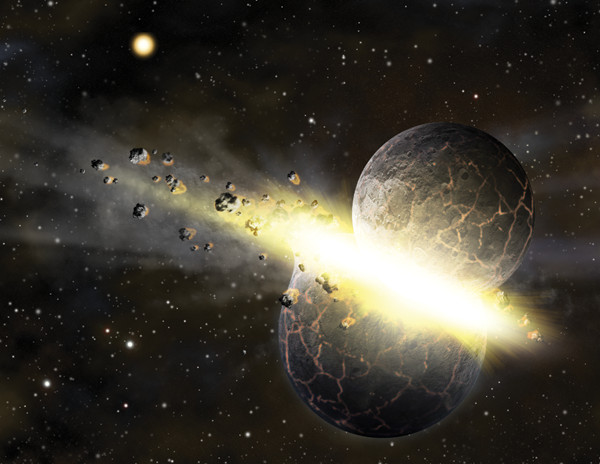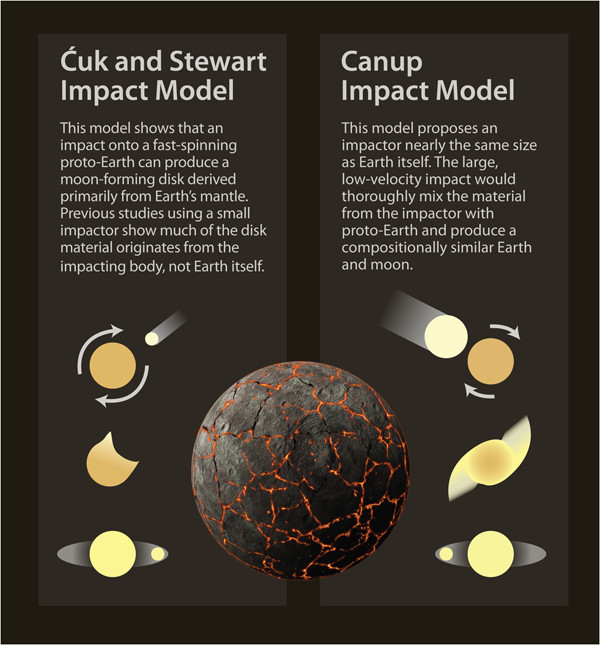
by Sara E. Pratt Wednesday, January 2, 2013

New models indicate that the moon could have indeed been born from Earth following a giant collision. Kathleen Cantner, AGI

Two new models show how a moon compositionally similar to Earth could have formed from a giant impact. Kathleen Cantner, AGI
Scientists are revisiting the age-old question of how Earth’s moon formed. New models indicate that it could have been born from the Earth following a giant collision after all.
The idea of a moon-forming collision is not new. The giant impact theory — the idea that a catastrophic collision about 4.5 billion years ago between Earth and a protoplanet about half Earth’s size created a disk of molten rock, gas and debris that consolidated to form the moon — was first set forth in the mid-1970s.
The temperature and rotational velocity of that disk would have determined what material ended up where as well as the conditions on the early moon. In the 1980s, computer modeling of the physics of such a collision suggested the moon would have formed mainly from the remnants of the pulverized foreign body, not from pieces of Earth. However, newer analytical evidence has since shown that the moon’s chemical composition closely matches the chemical composition of Earth’s mantle. Whereas all other known extraterrestrial bodies in the solar system today have different isotopic ratios than Earth, the moon has almost identical isotopic ratios.
“This seemed to create a problem: the match of lunar and Earth material is too perfect,” says William K. Hartmann, senior scientist at the Planetary Science Institute (PSI) in Tucson, Ariz., who, with Donald R. Davis, senior scientist and director emeritus of PSI, first proposed the giant impactor model of moon formation in 1975.
The perfect isotopic match called the giant impact theory into question and suggested the moon likely formed from Earth material, but how remained unknown. Now, two new models suggest different ways a giant impactor could produce a moon chemically similar to Earth.
In one model, Robin Canup, an astrophysicist at the Southwest Research Institute in Boulder, Colo., suggests a larger impactor than previously considered possible, about the same size as the early Earth. A collision with a similar-sized impactor would leave in its wake a mixture of debris from Earth and the impactor. After the planet consolidated, the remaining debris would produce a chemically similar moon, Canup reported in Science.
Although the collision of two similar-sized bodies, smaller than the modern Earth, was considered about 15 years ago, says Erik Asphaug, a planetary scientist at the University of California at Santa Cruz, the scenario was abandoned because the system resulted in too much angular momentum — which didn’t match today’s Earth-moon system. However, the understanding of orbital dynamics has advanced since then.
“The scenario hasn’t changed, so much as the interpretation that equal-mass collisions — that end up with the most spin — are allowable dynamically,” Asphaug says.
In another model published in the same issue of Science, astrophysicists Matija Ćuk and Sarah Stewart of Harvard University suggested a chemically similar moon could form if Earth was spinning much faster 4.5 billion years ago than it is today.
Ćuk and Stewart suggested a scenario in which a faster-spinning Earth was struck by a moderate-sized impactor, similar to those previously suggested. The higher rotational velocity would be sufficient, they report, to fling enough Earth material out into space to form a compositionally similar moon.
A faster spin rate would not be unexpected in the early solar system, said Ćuk in a Science podcast. In fact, at that time, day length may have been only two or three hours.
Previous impactor models had assumed the Earth-moon system had the same angular momentum that it has today. Although there is a point in the moon’s formation when the angular momentum could shift — specifically when the coalesced mass of debris is receding from the Earth — studies in the 1970s and 1980s had suggested it was unlikely.
“The work by Ćuk shows that this is actually not at all unlikely, if certain conditions about the internal structure of the Earth and moon are met,” Asphaug says. But, “it’s a big if.”
Ćuk, now at the SETI Institute in Mountain View, Calif., suggests the early Earth’s spin was slowed over time by interaction with the sun’s gravity. “The orbital momentum between the Earth and sun drains angular momentum from the system,” Ćuk said. “Eventually, it reached the present state.”
Hartmann says the “problem” that triggered the new research may not have been a problem after all. Although no other extraterrestrial bodies today have the same isotopic composition as Earth, a similar-sized body that formed near Earth in the early solar system, which could have become the future collider, may have.
“So from the point of view of Don [Davis] and me, the beautiful match between moon and Earth composition tends to support, not refute, the idea that the moon is formed from terrestrial material [that was] probably blown out and even triggered by a giant impact,” he says.
“The basic giant impact idea is still viable, still the main game in town, which, of course, does not mean it’s right,” Hartmann says. “I think more work needs to be done on exactly how much Earth material, including water-bearing material, actually got into the moon” and how long it took the material to mix, he says.
Lunar water is an issue because the giant impact theory entails some degree of melting on the early moon — from just the surface to possibly the entire moon. A large-scale collision likely would have led to heating and melting on the newly coalesced body that would have caused the moon’s water to evaporate, dehydrating it. But recent discoveries of water on the moon call into question whether such evaporation happened.
In an effort to determine if, or how much, the moon melted 4.5 billion years ago, scientists have turned to volatile elements, which would have off-gassed during an evaporation event. Heating of the moon would burn off the lighter isotopes of a volatile element, leaving behind its heavier counterparts. Such changes should still be detectable today, but previous studies have been inconclusive.
Now, in a new study in Nature, Randal Paniello and Frédéric Moynier of Washington University in St. Louis, Mo., and James Day of Scripps Institution of Oceanography reported that moon rocks have lower zinc concentrations than either Earth or Mars rocks, and that the zinc on the moon is isotopically heavier. The findings indicate a large-scale evaporation event likely did occur.
This study “strongly supports the idea that the moon formed out of a very hot silicate disk,” Asphaug says.
Evidence of such large-scale melting lends further support to the giant impact theory, but researchers agree that many questions still remain. “There is a huge amount of work to be done,” Asphaug says, “if we are ever to learn what happened to make the moon.”
© 2008-2021. All rights reserved. Any copying, redistribution or retransmission of any of the contents of this service without the expressed written permission of the American Geosciences Institute is expressly prohibited. Click here for all copyright requests.